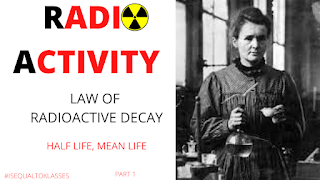MAHARASHTRA BOARD SOLUTIONS - CHAPTER 13 - CLASS 11 CHEMISTRY NUCLEAR CHEMISTRY AND RADIOACTIVITY
Half life of 18F is 110 minutes. What
fraction of 18F sample decays in 20
minutes ?
Half life of 35S is 87.8 d. What
percentage of 35S sample remains after
180 d ?
Half life 67Ga is 78 h. How long will it
take to decay 12% of sample of Ga ?
0.5 g Sample of 201Tl decays to 0.0788 g
in 8 days. What is its half life ?
65% of 111In sample decays in 4.2 d.
What is its half life ?
A 3/4 of the original amount of
radioisotope decays in 60 minutes. What
is its half life ?
How many - particles are emitted
by 0.1 g of 226Ra in one year?
A sample of 32P initially shows activity
of one Curie. After 303 days the activity
falls to 1.5 × 10^4 dps. What is the half life
of 32P ?
Half life of radon is 3.82 d. By what time
would 99.9 % of radon will be decayed.
fraction of 18F sample decays in 20
minutes ?
Half life of 35S is 87.8 d. What
percentage of 35S sample remains after
180 d ?
Half life 67Ga is 78 h. How long will it
take to decay 12% of sample of Ga ?
0.5 g Sample of 201Tl decays to 0.0788 g
in 8 days. What is its half life ?
65% of 111In sample decays in 4.2 d.
What is its half life ?
A 3/4 of the original amount of
radioisotope decays in 60 minutes. What
is its half life ?
How many - particles are emitted
by 0.1 g of 226Ra in one year?
A sample of 32P initially shows activity
of one Curie. After 303 days the activity
falls to 1.5 × 10^4 dps. What is the half life
of 32P ?
Half life of radon is 3.82 d. By what time
would 99.9 % of radon will be decayed.
A sample of old wood shows
7.0 dps/g. If the fresh sample of tree
shows 16.0 dps/g, How old is the given
sample of wood ? Half life of 14C
5730 y.






